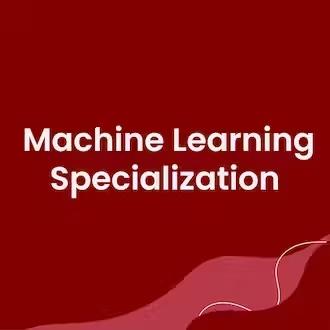English | MP4 | AVC 1280×720 | AAC 44KHz 2ch | 157 Lessons (23h 5m) | 3.45 GB
#BreakIntoAI with Machine Learning Specialization. Master fundamental AI concepts and develop practical machine learning skills in the beginner-friendly, 3-course program by AI visionary Andrew Ng
WHAT YOU WILL LEARN
Build ML models with NumPy & scikit-learn, build & train supervised models for prediction & binary classification tasks (linear, logistic regression)
Build & train a neural network with TensorFlow to perform multi-class classification, & build & use decision trees & tree ensemble methods
Apply best practices for ML development & use unsupervised learning techniques for unsupervised learning including clustering & anomaly detection
Build recommender systems with a collaborative filtering approach & a content-based deep learning method & build a deep reinforcement learning model
The Machine Learning Specialization is a foundational online program created in collaboration between DeepLearning.AI and Stanford Online. This beginner-friendly program will teach you the fundamentals of machine learning and how to use these techniques to build real-world AI applications.
This Specialization is taught by Andrew Ng, an AI visionary who has led critical research at Stanford University and groundbreaking work at Google Brain, Baidu, and Landing.AI to advance the AI field.
It provides a broad introduction to modern machine learning, including supervised learning (multiple linear regression, logistic regression, neural networks, and decision trees), unsupervised learning (clustering, dimensionality reduction, recommender systems), and some of the best practices used in Silicon Valley for artificial intelligence and machine learning innovation (evaluating and tuning models, taking a data-centric approach to improving performance, and more.)
By the end of this Specialization, you will have mastered key concepts and gained the practical know-how to quickly and powerfully apply machine learning to challenging real-world problems. If you’re looking to break into AI or build a career in machine learning, the new Machine Learning Specialization is the best place to start.
By the end of this Specialization, you will be ready to
- Build machine learning models in Python using popular machine learning libraries NumPy and scikit-learn.
- Build and train supervised machine learning models for prediction and binary classification tasks, including linear regression and logistic regression.
- Build and train a neural network with TensorFlow to perform multi-class classification.
- Apply best practices for machine learning development so that your models generalize to data and tasks in the real world.
- Build and use decision trees and tree ensemble methods, including random forests and boosted trees.
- Use unsupervised learning techniques for unsupervised learning: including clustering and anomaly detection.
- Build recommender systems with a collaborative filtering approach and a content-based deep learning method.
- Build a deep reinforcement learning model.
Table of Contents
advanced-learning-algorithms
neural-networks
neural-networks-intuition
1 welcome
2 neurons-and-the-brain
3 demand-prediction
4 example-recognizing-images
neural-network-model
5 neural-network-layer
6 more-complex-neural-networks
7 inference-making-predictions-forward-propagation
tensorflow-implementation
8 inference-in-code
9 data-in-tensorflow
10 building-a-neural-network
neural-network-implementation-in-python
11 forward-prop-in-a-single-layer
12 general-implementation-of-forward-propagation
speculations-on-artificial-general-intelligence-agi
13 is-there-a-path-to-agi
vectorization-optional
14 how-neural-networks-are-implemented-efficiently
15 matrix-multiplication
16 matrix-multiplication-rules
17 matrix-multiplication-code
neural-network-training
neural-network-training
18 tensorflow-implementation
19 training-details
activation-functions
20 alternatives-to-the-sigmoid-activation
21 choosing-activation-functions
22 why-do-we-need-activation-functions
multiclass-classification
23 multiclass
24 softmax
25 neural-network-with-softmax-output
26 improved-implementation-of-softmax
27 classification-with-multiple-outputs-optional
additional-neural-network-concepts
28 advanced-optimization
29 additional-layer-types
back-propagation-optional
30 what-is-a-derivative-optional
31 computation-graph-optional
32 larger-neural-network-example-optional
advice-for-applying-machine-learning
advice-for-applying-machine-learning
33 deciding-what-to-try-next
34 evaluating-a-model
35 model-selection-and-training-cross-validation-test-sets
bias-and-variance
36 diagnosing-bias-and-variance
37 regularization-and-bias-variance
38 establishing-a-baseline-level-of-performance
39 learning-curves
40 deciding-what-to-try-next-revisited
41 bias-variance-and-neural-networks
machine-learning-development-process
42 iterative-loop-of-ml-development
43 error-analysis
44 adding-data
45 transfer-learning-using-data-from-a-different-task
46 full-cycle-of-a-machine-learning-project
47 fairness-bias-and-ethics
skewed-datasets-optional
48 error-metrics-for-skewed-datasets
49 trading-off-precision-and-recall
decision-trees
decision-trees
50 decision-tree-model
51 learning-process
decision-tree-learning
52 measuring-purity
53 choosing-a-split-information-gain
54 putting-it-together
55 using-one-hot-encoding-of-categorical-features
56 continuous-valued-features
57 regression-trees-optional
tree-ensembles
58 using-multiple-decision-trees
59 sampling-with-replacement
60 random-forest-algorithm
61 xgboost
62 when-to-use-decision-trees
conversations-with-andrew-optional
63 andrew-ng-and-chris-manning-on-natural-language-processing
acknowledgments
64 acknowledgements_instructions
machine-learning
week-1-introduction-to-machine-learning
overview-of-machine-learning
65 welcome-to-machine-learning
66 applications-of-machine-learning
supervised-vs-unsupervised-machine-learning
67 what-is-machine-learning
68 supervised-learning-part-1
69 supervised-learning-part-2
70 unsupervised-learning-part-1
71 unsupervised-learning-part-2
72 jupyter-notebooks
practice-quiz-supervised-vs-unsupervised-learning
regression-model
73 linear-regression-model-part-1
74 linear-regression-model-part-2
75 cost-function-formula
76 cost-function-intuition
77 visualizing-the-cost-function
78 visualization-examples
practice-quiz-regression-model
train-the-model-with-gradient-descent
79 gradient-descent
80 implementing-gradient-descent
81 gradient-descent-intuition
82 learning-rate
83 gradient-descent-for-linear-regression
84 running-gradient-descent
practice-quiz-train-the-model-with-gradient-descent
week-2-regression-with-multiple-input-variables
multiple-linear-regression
85 multiple-features
86 vectorization-part-1
87 vectorization-part-2
88 gradient-descent-for-multiple-linear-regression
practice-quiz-multiple-linear-regression
gradient-descent-in-practice
89 feature-scaling-part-1
90 feature-scaling-part-2
91 checking-gradient-descent-for-convergence
92 choosing-the-learning-rate
93 feature-engineering
94 polynomial-regression
practice-quiz-gradient-descent-in-practice
week-2-practice-lab-linear-regression
95 week-2-practice-lab-linear-regression_instructions
week-3-classification
classification-with-logistic-regression
96 motivations
97 logistic-regression
98 decision-boundary
practice-quiz-classification-with-logistic-regression
cost-function-for-logistic-regression
99 cost-function-for-logistic-regression
100 simplified-cost-function-for-logistic-regression
practice-quiz-cost-function-for-logistic-regression
gradient-descent-for-logistic-regression
101 gradient-descent-implementation
practice-quiz-gradient-descent-for-logistic-regression
the-problem-of-overfitting
102 the-problem-of-overfitting
103 addressing-overfitting
104 cost-function-with-regularization
105 regularized-linear-regression
106 regularized-logistic-regression
practice-quiz-the-problem-of-overfitting
week-3-practice-lab-logistic-regression
107 week-3-practice-lab-logistic-regression_instructions
conversations-with-andrew-optional
108 andrew-ng-and-fei-fei-li-on-human-centered-ai
acknowledgments
109 acknowledgments_instructions
unsupervised-learning-recommenders-reinforcement-learning
unsupervised-learning
welcome-to-the-course
110 welcome
clustering
111 what-is-clustering
112 k-means-intuition
113 k-means-algorithm
114 optimization-objective
115 initializing-k-means
116 choosing-the-number-of-clusters
anomaly-detection
117 finding-unusual-events
118 gaussian-normal-distribution
119 anomaly-detection-algorithm
120 developing-and-evaluating-an-anomaly-detection-system
121 anomaly-detection-vs-supervised-learning
122 choosing-what-features-to-use
recommender-systems
collaborative-filtering
123 making-recommendations
124 using-per-item-features
125 collaborative-filtering-algorithm
126 binary-labels-favs-likes-and-clicks
recommender-systems-implementation-detail
127 mean-normalization
128 tensorflow-implementation-of-collaborative-filtering
129 finding-related-items
content-based-filtering
130 collaborative-filtering-vs-content-based-filtering
131 deep-learning-for-content-based-filtering
132 recommending-from-a-large-catalogue
133 ethical-use-of-recommender-systems
134 tensorflow-implementation-of-content-based-filtering
principal-component-analysis
135 reducing-the-number-of-features-optional
136 pca-algorithm-optional
137 pca-in-code-optional
reinforcement-learning
reinforcement-learning-introduction
138 what-is-reinforcement-learning
139 mars-rover-example
140 the-return-in-reinforcement-learning
141 making-decisions-policies-in-reinforcement-learning
142 review-of-key-concepts
state-action-value-function
143 state-action-value-function-definition
144 state-action-value-function-example
145 bellman-equation
146 random-stochastic-environment-optional
continuous-state-spaces
147 example-of-continuous-state-space-applications
148 lunar-lander
149 learning-the-state-value-function
150 algorithm-refinement-improved-neural-network-architecture
151 algorithm-refinement-greedy-policy
152 algorithm-refinement-mini-batch-and-soft-updates-optional
153 the-state-of-reinforcement-learning
summary-and-thank-you
154 summary-and-thank-you
conversations-with-andrew-optional
155 andrew-ng-and-chelsea-finn-on-ai-and-robotics
acknowledgments
156 acknowledgments_instructions
157 optional-opportunity-to-mentor-other-learners_instructions
Resolve the captcha to access the links!
